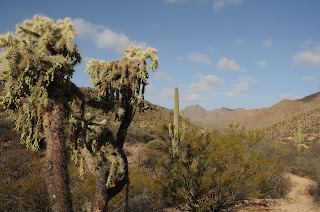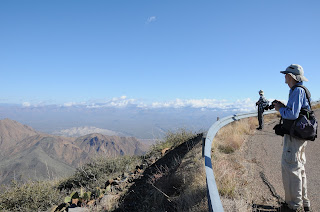JEWELS OVER JEROME
The flowing profiles of Mingus and
Woodchute Mountains are familiar sights hovering over the arty
community of Jerome. Popular year-round for hiking, camping and
day-trip picnicing, this recreation hub located between Prescott and
Jerome features trails that wander around the rounded summits and
precipitous edges. In autumn, forests of Gamble oaks and Big-tooth
maples that drench the slopes in warm shades of crimson and gold
add spectacular color to an already amazing set of trails. Here
are three to try.
WOODCHUTE MOUNTAIN TRAIL
Woodchute Wilderness Area
 |
| Woodchute Trail |
Cooler temperatures and shorter days of
autumn work together to paint the oak trees on Woodchute Mountain in
a palette of orange and gold. The mountain is really more of a long
ridgeline with Prescott Valley on one side and grand views of the red
cliffs of Sedona and the peaks of Flagstaff on the other.
Easy-to-follow, trail No. 102 meanders 3.7 miles up the mountain on a
moderate slope that swings from east to west showcasing vistas of
much of northern Arizona.
Beginning at 7,000', the hike
culminates with an easy stroll across a breezy high prairie that
dead-ends at the 7,600' east face of the mountain. Here, blood-red
maples and honey-colored scrub oaks frame views of Jerome and the
Verde Valley.
 |
| Gambel oaks on Woodchute Trail, Oct. 17th |
GETTING THERE: From Jerome, go 7
miles southwest on State Route 89A to the turn off for Potato Patch
Campground. Turn right and continue .3 mile to the signed road for
the Woodchute trailhead on the left and follow it to a parking loop
with restrooms. Those without a high clearance vehicle should park
here. To find the trailhead, head right (east) and hike or drive
(high clearance needed) up Forest Road 106 (also signed as FR
102/106) for a half-mile to the wilderness sign and trail register.
If you opt to hike the road, add 1 mile to the trip length above.
VIEW POINT TRAIL
Prescott National Forest
 |
| View Point Trail, Oct. 10th |
A traipse through an archway
of toasty golden oaks sets the stage for the hallmark mountain vistas
and brilliant foliage of the View Point Trail No. 106. Beyond this
“grand entrance” the slender path begins its gradual, 2-mile
descent along the east face of Mingus Mountain weaving through a
mixed bag of terrain including exposed juniper-agave high desert and
pine-oak forests fringed with Big-tooth maples. From the trail’s
high vantage point, the towns of Jerome and Cottonwood appear like
scribbles on a map far below while the course of the Verde River
paints a lazy swath of green on a brown landscape. Just past the
1.3-mile mark, at the junction for trail 105A, the route makes a
severe dip into the canyon. It’s here where the hike rating goes
from moderate to difficult as the path clamors roughly 700 feet
downhill on loose rocks to the turn around point at Allen Springs
Road. Casual hikes can opt to stay on the high road and make the
junction their turnaround point instead. Elevation range is 7,800' -
6,000'.
 |
| View Point Trail, Oct 10th |
GETTING THERE: From
Jerome, go 7 miles southwest on State Route 89A to Mingus Mountain
Road (Forest Road 104). Turn left and continue on FR 104 for 2.4
miles to where it ends at a “T” intersection in the campground.
Take an immediate left and park in the circular turnout near the
“106” trail sign.
NORTH MINGUS TRAIL
Prescott National Forest
 |
| North Mingus Trail, Oct 11th |
An eclectic mix of scenery
and forests are the highlights of the North Mingus Trail No.105.
Although there are two trailheads for this route, most hikers choose
to start at the top of Mingus Mountain and hike downhill. That’s
because the route is easier to follow when hiked in this direction.
Right from the start, this popular trail will “wow” you with
magnificent views from 7,800 feet atop a pine-shaded hang glider
launch pad.
Here, the rugged Verde
Valley rolls out 1,600 feet below. The 8.5-mile roundtrip hike begins
with a pleasant stroll across the mountain summit under a canopy of
warm gold Gambel oaks huddling beneath enormous conifirs. After this
short “warm up” section, the trail dips downhill along the north
face through colorful corridors of Big-tooth maples, boxelders and
velvet ash. Soon, the path enters an enchanting passage where a mass
of volcanic boulders cascade down a slender slot canyon where
vertical stony walls and a stand of aspens thrive in the cooler
microclimate. Past the aspen grove, the trail enters a more arid
clime with intermittent sections of grasslands, fields of agave and
ridgelines studded with whispy mountain mahogany. An abandoned mine
marks the point where the trail merges with an old Jeep road that
leads downhill to Mescal Spring at 6,000 feet, the turnaround point
for the hike. This trail also can be hiked one-way using a car
shuttle at each trailhead.
 |
| North Mingus Trail, Oct 11th |
GETTING THERE: Mingus
Mountain trailhead: From Jerome, go 7 miles southwest on Highway
89A to Mingus Mountain Road (Forest Road 104). Turn left and continue
on FR 104 for 2.4 miles to where it ends at a “T” intersection in
the campground. Turn left here and go uphill to the trailhead near
the hang glider launch pad. Mescal Spring trailhead: From
Jerome, go 4 miles southwest on Highway 89A. Just before sign for
Prescott National Forest, between mileposts 339 and 338, turn left
onto an unmarked dirt road (Forest Road 338). FR 338 is a very rough
4x4 road so those without appropriate vehicles should park in the
turnouts along the highway. Continue down FR 338 for a half-mile to
the cement tank that marks Mescal Spring. From here, veer right
(southwest) and go uphill. Bear left at all unmarked junctions until
you reach the signed turn off for trail No. 105 on the right. This
route adds one mile to the hike description above.

























































